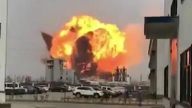【新唐人2011年11月19日訊】北京空氣污染的問題存在已久,美國駐華大使館發佈的空氣品質檢測資料,和北京市環保局公布的空氣監測結果嚴重反差,民眾質疑地方政府採用的監測方法和公布的數據。
最近,美國駐北京使領館測出的空氣品質,結果和地方環保局發佈的數據相差很大。明明是灰濛濛的天空,看不見藍天也沒有白雲,但北京環保監測數據卻顯示,空氣品質達到優良標準。
北京市環保局在前不久發表一份聲明指出,今年1月到10月,北京空氣品質優良天數達239天。
然而,中共環保部部長周生賢在一次會議上談到,“人民群眾深受污染之害、苦不堪言,而監測數據喜氣洋洋、自說自話”。
在發達國家,PM2.5數據是環境控制質量評價的一項重要指標,也是空氣質量的一個主要依據。美國使領館檢測北京空氣品質使用的是PM2.5標準,而中國的空氣品質報告監測的是直徑在10微米以下的可吸入顆粒物,就是PM10。
因為PM2.5粒子比PM10更微小,大約是人體頭髮直徑的1/28,因此對人體健康影響更大,尤其是對老人、小孩或易過敏性體質等民眾,更具有高度的健康風險。
而《北京日報》11月4號發表一篇文章,題目叫《空氣質量數據不該看別人臉色》。內容提到美國駐華使館檢測並公布北京的空氣品質,是別有用心。
中國當代作家鄭義:「美國人有知情權,他們需要知道他們工作地點,他們到底受到了多大的,這個空氣有多麼嚴重的污染,而他們又不是那麼太相信中國發佈的數據,所以美國大使館沒有辦法,他們自己搞一套儀器, 就在美國大使館網站上面公布,後來很多中國人覺得美國大使館空氣監測數據,跟北京人的感受比較一致,所以這個駐北京美國大使館的空氣監測數據,很受到大家的歡迎。」
中國環境空氣質量標準中不含PM2.5,空氣質量監測和評價中缺乏對灰霾天氣的評估。中國環保部官員11月16號說,這項更為嚴格的空氣質量監測標準目前還無法在全國鋪開。
中國當代作家鄭義:「這個標準一改變的話,我認為會更準確的反應中國空氣污染的程度,對於老百姓,當然是非常好的了,讓大家能夠知道真實的情況,尤其是跟自己身體健康密切相關的這種真實情況,當然對於各個地方政府來說的話,就不是一件好事。當然他也承認了一個事實,就是”我們北京自己的檢測標準跟人家的不一樣”,也就是北京官方說的輕度污染,就等於美國大使館公布的有毒害的污染。」
綠色和平組織中國辦公室主任周嶸告訴《美國之音》,中國東部人口密度比較高,污染較為嚴重的城市地區,僅僅公布PM10的監測結果,是無法說明空氣品質到底有多差。
周嶸:「政府更多的時候是會覺得這個數據一拿出來會讓自己很丟臉。所以就始終不願意去公布這些數據。」
中共環保部近期進行的《環境空氣品質標準》修訂中,對於PM2.5僅設立了參考限值。“編製説明”解釋,目前PM2.5污染較重,如果實施PM2.5標準,中國空氣品質將大範圍超標。
新唐人記者常春、黃容、王明宇採訪報導。
Air Pollution Data Conflicts
Beijing’s air pollution problem has long existed.
The U.S. Embassy has issued air quality monitoring data,
which are quite different from the results of the
Beijing Municipal Environmental Protection Bureau.
The public has questioned the monitoring methods used by
the local government and their published data.
Recently, the U.S. embassy posted air quality measured
in Beijing, and the results varied widely from local data.
The sky is obviously gray, it not being possible to see blue sky
or white clouds,
but the Beijing environmental monitoring data
have nevertheless shown that it meets quality standards.
http://big5.china.com.cn/news/txt/2011-11/07/content_23840003.htm
The Beijing Municipal Environmental Protection Bureau said
in a statement released recently, that,
from January to October 2011,
Beijing’s good air quality days were up to 239 days.
However, Zhou Shengxian, Chinese Environmental Protection
Minister , spoke at a meeting saying : “The people are victims of pollution,
and they are not happy about it, but monitoring data
are beaming, telling their own stories."
In developed countries, PM2.5 data is an important indicator
in environmental control quality assessment, and also a major factor in air quality assessment.
Beijing’s U.S. Embassy air quality test used the PM2.5 standard,
while China’s air quality monitoring report is based on a
reparable particulate of less than 10 microns in diameter, PM10.
PM2.5 particles are even smaller than PM10,
and their diameter is about 1 / 28 of human hair, so they have a greater impact on human health,
especially for the elderly, children or others who can easily be
allergic, and have a high degree of health risk.
On November 4, Beijing Daily published an article,
Air Quality Data Should Not Be Seen Publicly,
It said the U.S. Embassy had ulterior motives
when showing air quality detected in Beijing.
Zheng Yi, Chinese contemporary writer says: “Americans
have the right to know, they need to know in their place of work,
how much air pollution they are suffering.
They do not believe much of the data published in China.
The United States Embassy has no other way
but to use their own set of instruments, and to publish the results on their website.
A lot of Chinese people think the U.S. Embassy monitoring data,
are more consistent with their experience of Beijing air quality.
So the U.S. Embassy monitoring data of air quality in Beijing,
is welcomed by everyone."
Air quality standards in China have no PM2.5, and lack
haze assessment in air quality monitoring and evaluation.
Chinese environmental officials said on November 16,
that a more stringent standard for air quality monitoring is difficult to use across the country.
Zheng Yi, Chinese contemporary writer says: “Once the
standard changes, it will reflect China’s air pollution more accurately.
For people, it is very good, letting them know the real situation,
especially the real situation closely related to their own health.
For all local governments, (lack of accuracy) is not a good thing.
They also acknowledged the fact that “our own testing standards
in Beijing are different from those of others”.
That is, the light pollution reported by Beijing officials,
is equivalent to toxic pollution details released in data from the U.S. Embassy."
Zhou Rong, Director of Green Peace China Office told
Voice of America that population density is relatively high in eastern China. In urban areas,
where pollution is more serious, only PM10 monitoring results are released,
which do not explain how bad the air quality is.
Zhou Rong: “The government finds the data shames them,
sand so has always been reluctant to publish these data."
In recent revision by the Chinese Ministry of Environmental
Protection, in amendments relating to Ambient Air Quality Standards,
it only sets up a reference of limits for PM2.5.
It is explained in their instructions that the current pollution is heavy in PM2.5.
If using PM2.5 standard, air quality in China will be out of
standard in large areas.
NTD reporters Chang Chun , Huang Rong and Wang Mingyu





























